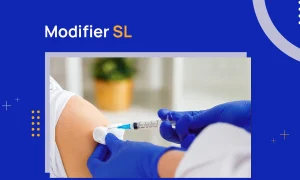Medical billing is hard, even for experienced billers. Incorrect coding and small mistakes lead to denied claims, delayed payments, and potential compliance issues. Most facilities lose thousands of dollars yearly because of simple coding mistakes that could easily be prevented with proper understanding.
CPT code 96365 is one such code that requires careful attention to documentation and application. Even though it represents a simple procedure, many billers get it wrong. This comprehensive guide will walk you through everything you need to know about CPT code 96365. So, let’s start.
CPT Code 96365 Description
The American Medical Association (AMA) defines CPT code 96365 as: “Intravenous infusion, for therapy, prophylaxis, or diagnosis (specify substance or drug); initial, up to 1 hour.” This code falls under the ‘Therapeutic, Prophylactic, and Diagnostic Injections and Infusions’ section of the CPT coding system.
It is important to note that 96365 specifically represents the initial intravenous infusion of a substance or drug for therapeutic, prophylactic, or diagnostic purposes administered intravenously (IV). An important point many billers miss while using this code is that the infusions must exceed at least 15 minutes and remain under 1 hour. Infusions that last less than 15 minutes are classified as IV pushes and require different CPT codes for billing.
Additionally, CPT code 96365 is exclusively used for non-chemotherapy infusions. Chemotherapy infusions use a separate CPT coding structure, which usually ranges from 96413 to 96417.
Appropriate Use Cases for CPT Code 96365
Knowing exactly when to apply this code can prevent billing errors and ensure proper reimbursement. Below are a couple of clinical situations where CPT code 96365 can be used:
Therapeutic Administration
CPT code 96365 can be used when doctors administer medications intravenously for therapeutic purposes. For example, it can be used for the following:
- IV antibiotics treating active infections
- Pain medication infusions for acute or chronic pain control
- Immunoglobulin therapy for patients with immune disorders
- Specialty medications treating chronic conditions like multiple sclerosis, rheumatoid arthritis, or Crohn’s disease
Preventative Administration
Prophylactic infusions are used as a preventive measure to restrict the spread of diseases or mitigate medical complications. Situations where 96365 would apply include:
- Administration of preventive antibiotics before surgical procedures
- Anti-rejection medication for transplant patients
- Administration of prophylactic antivirals in immunocompromised patients
When NOT to Use CPT Code 96365
- For hydration services only
- For chemotherapy administration
- For IV push services (15 minutes or less)
- When the IV fluid is merely a vehicle for drug administration and not separately billable
- For concurrent infusions of the same drug
Modifiers to Append with CPT Code 96365
Filing an insurance claim is more than just using the correct code. For successful reimbursement, you must explain the circumstances in which the procedure or service was performed. Modifiers serve this exact purpose. For CPT code 96365, the following modifiers prove particularly relevant:
| Modifier | Description | Explanation |
|---|---|---|
| 59 | Distinct Procedural Service | Used when the infusion service is distinct and separate from other services performed on the same day. |
| 52 | Reduced Service | Used if the infusion was started but discontinued before completion for some reason, resulting in a service that is less than what the code typically represents. |
| LT | Left Side | Used to explain that the IV catheter was inserted in a vein on the left side of the body (arm, wrist, hand) |
| RT | Right Side | Used to explain that the IV catheter was inserted in a vein on the right side of the body (arm, wrist, hand) |
| XE | Separate Encounter | Used to indicate that the service was performed during a separate encounter on the same day. |
Remember, you can not just use modifiers without context and need. Every modifier you use must be supported with thorough documentation. Many audit findings stem from modifiers without adequate supporting documentation in medical records.
Reimbursement Guidelines for CPT Code 96365
The following are some billing and reimbursement guidelines that you should follow to improve your claim acceptance rate.
Documentation
Documentation is essential to justify the procedure and the use of modifiers. For CPT code 96365, providers must document:
- Start and Stop Times: The exact start and stop times of the infusion must be documented clearly. This is crucial as the code is time-based, requiring more than 15 minutes but not exceeding 1 hour.
- Medication Details: Specific drug or substance infused, including dosage and concentration.
- Method of Administration: Clear indication that delivery occurred intravenously.
- Medical Justification: Documented reason explaining why the infusion was medically necessary.
- Clinical Staff: The healthcare professional administering the procedure should be identified in the documentation.
Infusion Hierarchy
If multiple infusions are performed on the same day, the insurance payers must follow the following sequence for reimbursement.
- Chemotherapy infusions (highest priority if applicable)
- Therapeutic/diagnostic/prophylactic infusions (CPT 96365)
- IV push services
- Hydration services (lowest priority)
The “initial” service describes the primary reason for the visit. It does not necessarily have to be the first service administered chronologically. This distinction confuses many coders. Following this hierarchy is mandatory, and disregarding it will likely result in denials.
Coding for Multiple Infusions
If multiple infusion services are performed after the first hour during the same patient visit, the subsequent infusions must not be billed with CPT code 96365. In this scenario, the following codes may apply:
- 96366: Each additional hour of the same infusion (after the initial hour coded with 96365).
- 96367: Sequential infusion of a new drug/substance, up to 1 hour.
- 96368: Concurrent infusion (administered simultaneously through separate access sites or lumens of the same access site).
Final Thoughts on CPT Code 96365
CPT code 96365 represents a specific type of intravenous infusion. Use comprehensive documentation and pay close attention to timing requirements and coding rules to successfully file 96365 claims and avoid denials.
Staying updated with the latest coding and payer policies is essential, as these factors directly affect how providers should report CPT 96365 and what payment amounts they can expect. If you find all this confusing and hard to manage, contact our specialists for the best internal medicine medical billing and coding services.
FAQs
What is the difference between 96365 and 96374?
CPT code 96365 is for the initial intravenous (IV) infusion of a medication or substance for therapy, prophylaxis, or diagnosis, lasting up to 1 hour. CPT code 96374 is for an IV push of a single or initial substance/drug, administered in 15 minutes or less. The key difference is that 96365 involves a longer infusion (up to 1 hour), while 96374 is for a rapid IV push (≤15 minutes).
Can we bill CPT Codes 96365 and 96413 together?
Yes, CPT codes 96365 and 96413 can be billed together since the therapies and their purpose are distinct. Moreover, the drugs must be administered through separate IV access, and properly documented.



